Combined Article Critique: Impact of TV on Childhood Obesity Study
VerifiedAdded on 2023/06/10
|6
|1330
|345
Report
AI Summary
This report provides a combined critique of two articles focusing on childhood obesity and its relationship with television viewing. The first article is a qualitative study that examines the challenges parents face in adhering to the American Academy of Pediatrics (AAP) guidelines limiting children's TV time, exploring the barriers related to children's reactions, lack of alternative resources, and perceived benefits of family television use. The researchers employed interviews and surveys within Bronfenbrenner's ecological systems model to understand the contextual complexities of family dynamics. The second article is a quantitative study by the World Health Organization (WHO) which assesses childhood obesity levels in multiple countries, linking obesity to dietary habits, screen time, and sleep patterns. The WHO study uses statistical data to highlight the negative health consequences of excessive screen time and poor nutrition in children. Both articles, when viewed together, highlight the multifaceted nature of childhood obesity, emphasizing the importance of addressing both environmental and behavioral factors to promote children's health.
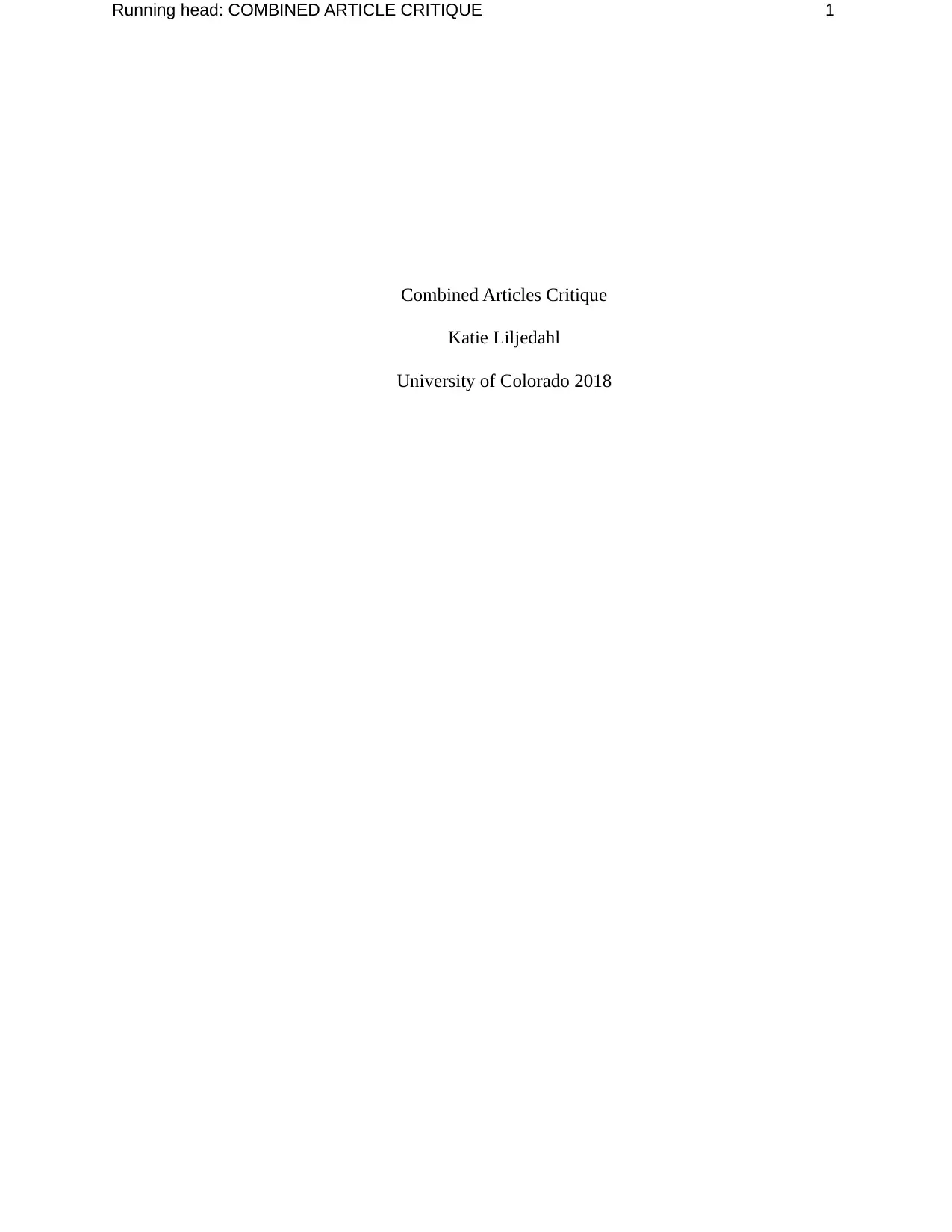
Running head: COMBINED ARTICLE CRITIQUE 1
Combined Articles Critique
Katie Liljedahl
University of Colorado 2018
Combined Articles Critique
Katie Liljedahl
University of Colorado 2018
Paraphrase This Document
Need a fresh take? Get an instant paraphrase of this document with our AI Paraphraser
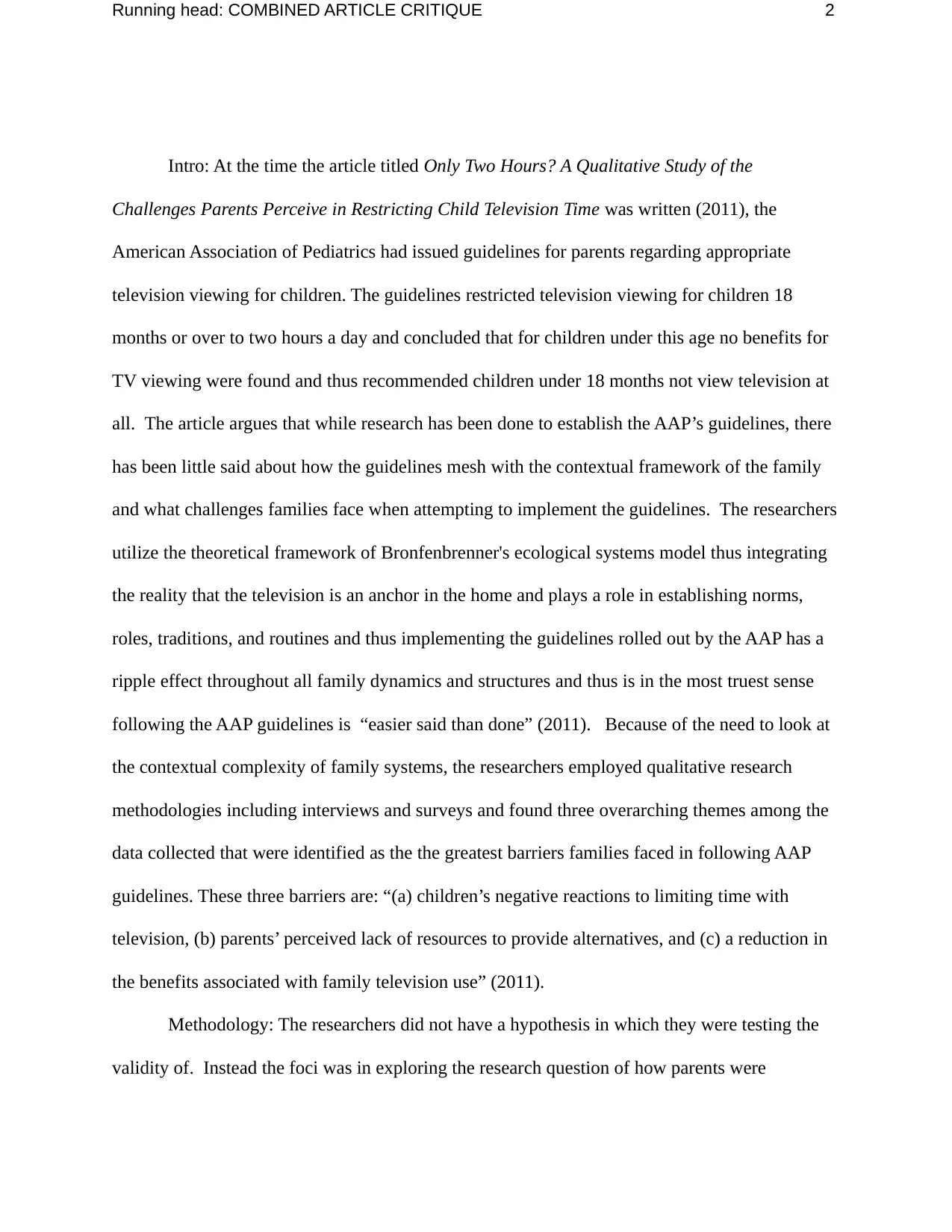
Running head: COMBINED ARTICLE CRITIQUE 2
Intro: At the time the article titled Only Two Hours? A Qualitative Study of the
Challenges Parents Perceive in Restricting Child Television Time was written (2011), the
American Association of Pediatrics had issued guidelines for parents regarding appropriate
television viewing for children. The guidelines restricted television viewing for children 18
months or over to two hours a day and concluded that for children under this age no benefits for
TV viewing were found and thus recommended children under 18 months not view television at
all. The article argues that while research has been done to establish the AAP’s guidelines, there
has been little said about how the guidelines mesh with the contextual framework of the family
and what challenges families face when attempting to implement the guidelines. The researchers
utilize the theoretical framework of Bronfenbrenner's ecological systems model thus integrating
the reality that the television is an anchor in the home and plays a role in establishing norms,
roles, traditions, and routines and thus implementing the guidelines rolled out by the AAP has a
ripple effect throughout all family dynamics and structures and thus is in the most truest sense
following the AAP guidelines is “easier said than done” (2011). Because of the need to look at
the contextual complexity of family systems, the researchers employed qualitative research
methodologies including interviews and surveys and found three overarching themes among the
data collected that were identified as the the greatest barriers families faced in following AAP
guidelines. These three barriers are: “(a) children’s negative reactions to limiting time with
television, (b) parents’ perceived lack of resources to provide alternatives, and (c) a reduction in
the benefits associated with family television use” (2011).
Methodology: The researchers did not have a hypothesis in which they were testing the
validity of. Instead the foci was in exploring the research question of how parents were
Intro: At the time the article titled Only Two Hours? A Qualitative Study of the
Challenges Parents Perceive in Restricting Child Television Time was written (2011), the
American Association of Pediatrics had issued guidelines for parents regarding appropriate
television viewing for children. The guidelines restricted television viewing for children 18
months or over to two hours a day and concluded that for children under this age no benefits for
TV viewing were found and thus recommended children under 18 months not view television at
all. The article argues that while research has been done to establish the AAP’s guidelines, there
has been little said about how the guidelines mesh with the contextual framework of the family
and what challenges families face when attempting to implement the guidelines. The researchers
utilize the theoretical framework of Bronfenbrenner's ecological systems model thus integrating
the reality that the television is an anchor in the home and plays a role in establishing norms,
roles, traditions, and routines and thus implementing the guidelines rolled out by the AAP has a
ripple effect throughout all family dynamics and structures and thus is in the most truest sense
following the AAP guidelines is “easier said than done” (2011). Because of the need to look at
the contextual complexity of family systems, the researchers employed qualitative research
methodologies including interviews and surveys and found three overarching themes among the
data collected that were identified as the the greatest barriers families faced in following AAP
guidelines. These three barriers are: “(a) children’s negative reactions to limiting time with
television, (b) parents’ perceived lack of resources to provide alternatives, and (c) a reduction in
the benefits associated with family television use” (2011).
Methodology: The researchers did not have a hypothesis in which they were testing the
validity of. Instead the foci was in exploring the research question of how parents were
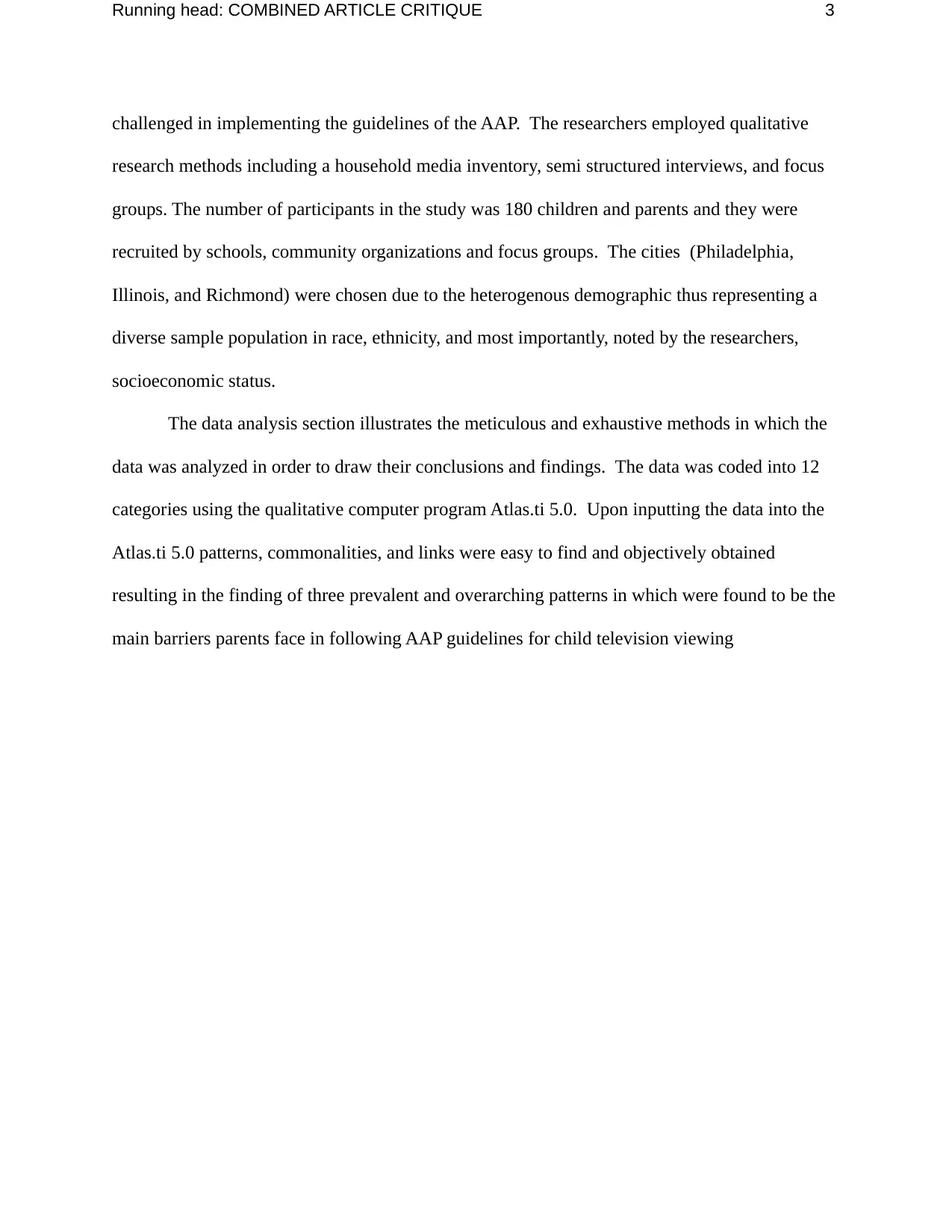
Running head: COMBINED ARTICLE CRITIQUE 3
challenged in implementing the guidelines of the AAP. The researchers employed qualitative
research methods including a household media inventory, semi structured interviews, and focus
groups. The number of participants in the study was 180 children and parents and they were
recruited by schools, community organizations and focus groups. The cities (Philadelphia,
Illinois, and Richmond) were chosen due to the heterogenous demographic thus representing a
diverse sample population in race, ethnicity, and most importantly, noted by the researchers,
socioeconomic status.
The data analysis section illustrates the meticulous and exhaustive methods in which the
data was analyzed in order to draw their conclusions and findings. The data was coded into 12
categories using the qualitative computer program Atlas.ti 5.0. Upon inputting the data into the
Atlas.ti 5.0 patterns, commonalities, and links were easy to find and objectively obtained
resulting in the finding of three prevalent and overarching patterns in which were found to be the
main barriers parents face in following AAP guidelines for child television viewing
challenged in implementing the guidelines of the AAP. The researchers employed qualitative
research methods including a household media inventory, semi structured interviews, and focus
groups. The number of participants in the study was 180 children and parents and they were
recruited by schools, community organizations and focus groups. The cities (Philadelphia,
Illinois, and Richmond) were chosen due to the heterogenous demographic thus representing a
diverse sample population in race, ethnicity, and most importantly, noted by the researchers,
socioeconomic status.
The data analysis section illustrates the meticulous and exhaustive methods in which the
data was analyzed in order to draw their conclusions and findings. The data was coded into 12
categories using the qualitative computer program Atlas.ti 5.0. Upon inputting the data into the
Atlas.ti 5.0 patterns, commonalities, and links were easy to find and objectively obtained
resulting in the finding of three prevalent and overarching patterns in which were found to be the
main barriers parents face in following AAP guidelines for child television viewing
⊘ This is a preview!⊘
Do you want full access?
Subscribe today to unlock all pages.

Trusted by 1+ million students worldwide
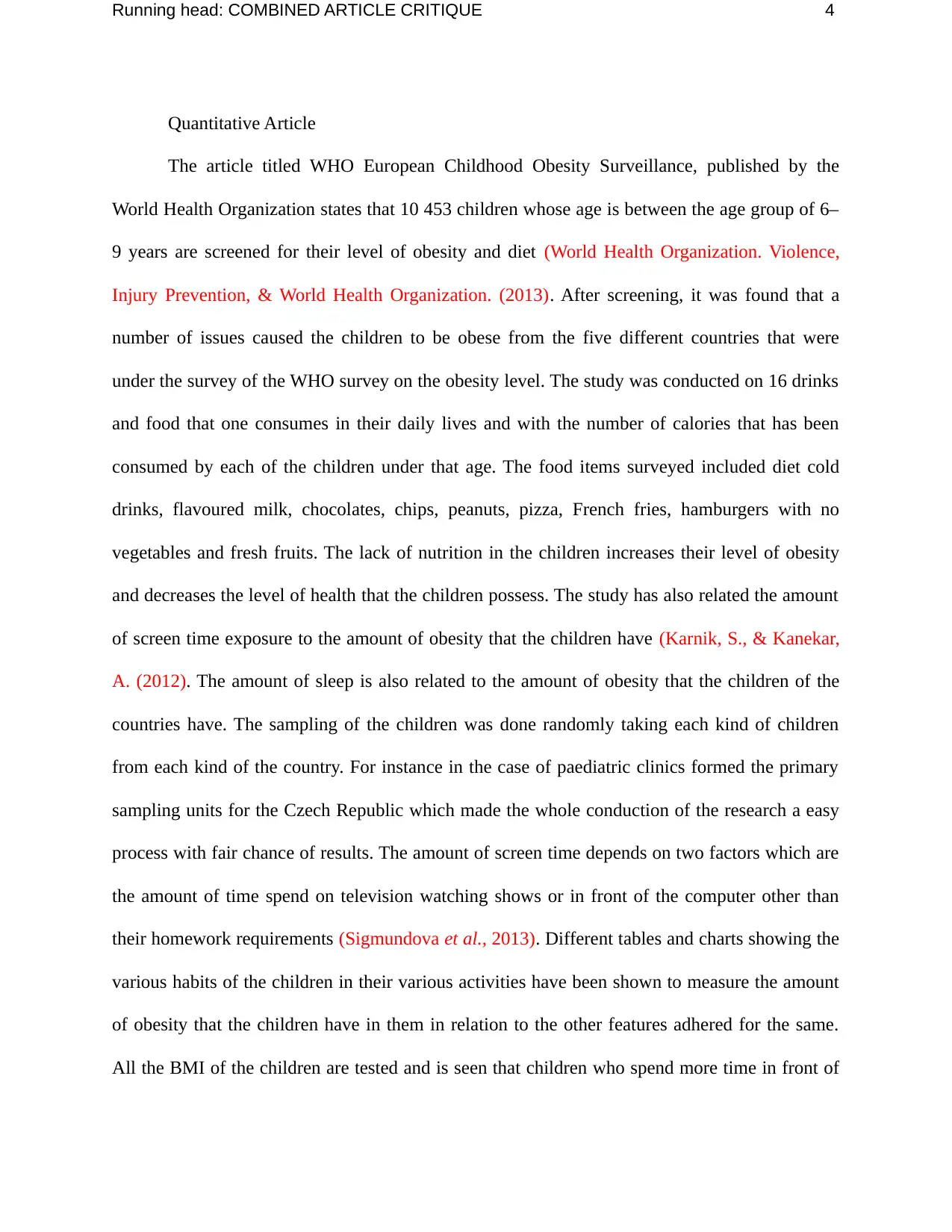
Running head: COMBINED ARTICLE CRITIQUE 4
Quantitative Article
The article titled WHO European Childhood Obesity Surveillance, published by the
World Health Organization states that 10 453 children whose age is between the age group of 6–
9 years are screened for their level of obesity and diet (World Health Organization. Violence,
Injury Prevention, & World Health Organization. (2013). After screening, it was found that a
number of issues caused the children to be obese from the five different countries that were
under the survey of the WHO survey on the obesity level. The study was conducted on 16 drinks
and food that one consumes in their daily lives and with the number of calories that has been
consumed by each of the children under that age. The food items surveyed included diet cold
drinks, flavoured milk, chocolates, chips, peanuts, pizza, French fries, hamburgers with no
vegetables and fresh fruits. The lack of nutrition in the children increases their level of obesity
and decreases the level of health that the children possess. The study has also related the amount
of screen time exposure to the amount of obesity that the children have (Karnik, S., & Kanekar,
A. (2012). The amount of sleep is also related to the amount of obesity that the children of the
countries have. The sampling of the children was done randomly taking each kind of children
from each kind of the country. For instance in the case of paediatric clinics formed the primary
sampling units for the Czech Republic which made the whole conduction of the research a easy
process with fair chance of results. The amount of screen time depends on two factors which are
the amount of time spend on television watching shows or in front of the computer other than
their homework requirements (Sigmundova et al., 2013). Different tables and charts showing the
various habits of the children in their various activities have been shown to measure the amount
of obesity that the children have in them in relation to the other features adhered for the same.
All the BMI of the children are tested and is seen that children who spend more time in front of
Quantitative Article
The article titled WHO European Childhood Obesity Surveillance, published by the
World Health Organization states that 10 453 children whose age is between the age group of 6–
9 years are screened for their level of obesity and diet (World Health Organization. Violence,
Injury Prevention, & World Health Organization. (2013). After screening, it was found that a
number of issues caused the children to be obese from the five different countries that were
under the survey of the WHO survey on the obesity level. The study was conducted on 16 drinks
and food that one consumes in their daily lives and with the number of calories that has been
consumed by each of the children under that age. The food items surveyed included diet cold
drinks, flavoured milk, chocolates, chips, peanuts, pizza, French fries, hamburgers with no
vegetables and fresh fruits. The lack of nutrition in the children increases their level of obesity
and decreases the level of health that the children possess. The study has also related the amount
of screen time exposure to the amount of obesity that the children have (Karnik, S., & Kanekar,
A. (2012). The amount of sleep is also related to the amount of obesity that the children of the
countries have. The sampling of the children was done randomly taking each kind of children
from each kind of the country. For instance in the case of paediatric clinics formed the primary
sampling units for the Czech Republic which made the whole conduction of the research a easy
process with fair chance of results. The amount of screen time depends on two factors which are
the amount of time spend on television watching shows or in front of the computer other than
their homework requirements (Sigmundova et al., 2013). Different tables and charts showing the
various habits of the children in their various activities have been shown to measure the amount
of obesity that the children have in them in relation to the other features adhered for the same.
All the BMI of the children are tested and is seen that children who spend more time in front of
Paraphrase This Document
Need a fresh take? Get an instant paraphrase of this document with our AI Paraphraser
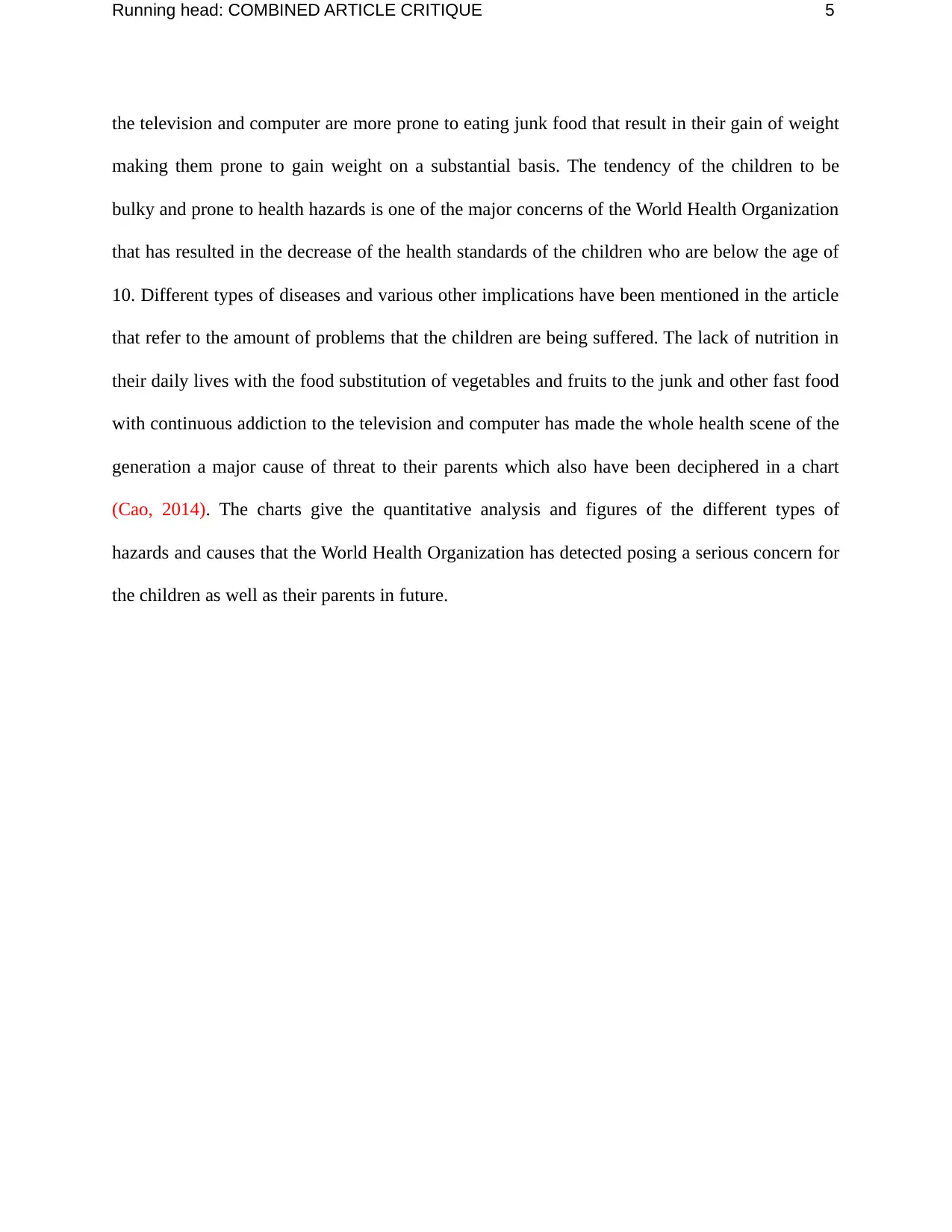
Running head: COMBINED ARTICLE CRITIQUE 5
the television and computer are more prone to eating junk food that result in their gain of weight
making them prone to gain weight on a substantial basis. The tendency of the children to be
bulky and prone to health hazards is one of the major concerns of the World Health Organization
that has resulted in the decrease of the health standards of the children who are below the age of
10. Different types of diseases and various other implications have been mentioned in the article
that refer to the amount of problems that the children are being suffered. The lack of nutrition in
their daily lives with the food substitution of vegetables and fruits to the junk and other fast food
with continuous addiction to the television and computer has made the whole health scene of the
generation a major cause of threat to their parents which also have been deciphered in a chart
(Cao, 2014). The charts give the quantitative analysis and figures of the different types of
hazards and causes that the World Health Organization has detected posing a serious concern for
the children as well as their parents in future.
the television and computer are more prone to eating junk food that result in their gain of weight
making them prone to gain weight on a substantial basis. The tendency of the children to be
bulky and prone to health hazards is one of the major concerns of the World Health Organization
that has resulted in the decrease of the health standards of the children who are below the age of
10. Different types of diseases and various other implications have been mentioned in the article
that refer to the amount of problems that the children are being suffered. The lack of nutrition in
their daily lives with the food substitution of vegetables and fruits to the junk and other fast food
with continuous addiction to the television and computer has made the whole health scene of the
generation a major cause of threat to their parents which also have been deciphered in a chart
(Cao, 2014). The charts give the quantitative analysis and figures of the different types of
hazards and causes that the World Health Organization has detected posing a serious concern for
the children as well as their parents in future.
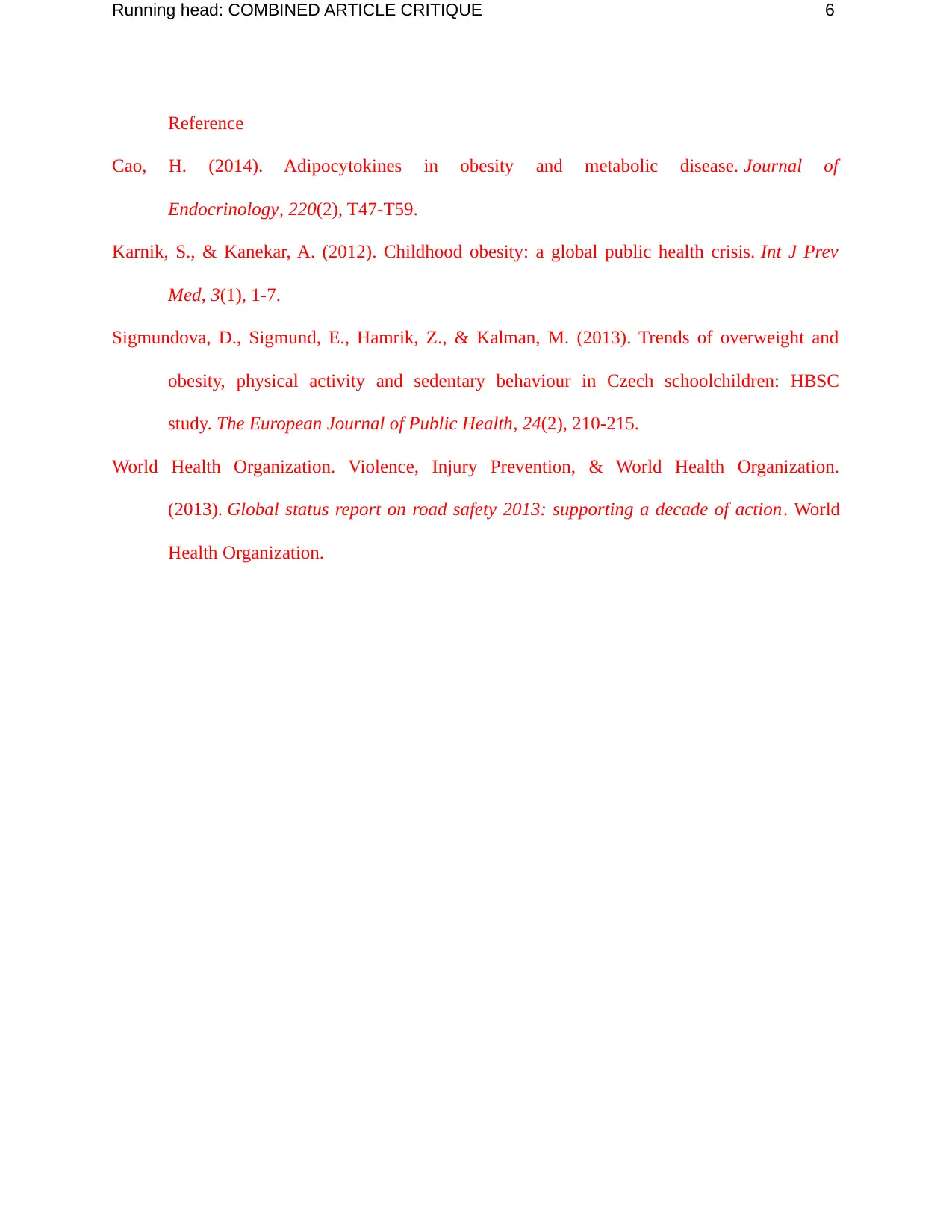
Running head: COMBINED ARTICLE CRITIQUE 6
Reference
Cao, H. (2014). Adipocytokines in obesity and metabolic disease. Journal of
Endocrinology, 220(2), T47-T59.
Karnik, S., & Kanekar, A. (2012). Childhood obesity: a global public health crisis. Int J Prev
Med, 3(1), 1-7.
Sigmundova, D., Sigmund, E., Hamrik, Z., & Kalman, M. (2013). Trends of overweight and
obesity, physical activity and sedentary behaviour in Czech schoolchildren: HBSC
study. The European Journal of Public Health, 24(2), 210-215.
World Health Organization. Violence, Injury Prevention, & World Health Organization.
(2013). Global status report on road safety 2013: supporting a decade of action. World
Health Organization.
Reference
Cao, H. (2014). Adipocytokines in obesity and metabolic disease. Journal of
Endocrinology, 220(2), T47-T59.
Karnik, S., & Kanekar, A. (2012). Childhood obesity: a global public health crisis. Int J Prev
Med, 3(1), 1-7.
Sigmundova, D., Sigmund, E., Hamrik, Z., & Kalman, M. (2013). Trends of overweight and
obesity, physical activity and sedentary behaviour in Czech schoolchildren: HBSC
study. The European Journal of Public Health, 24(2), 210-215.
World Health Organization. Violence, Injury Prevention, & World Health Organization.
(2013). Global status report on road safety 2013: supporting a decade of action. World
Health Organization.
⊘ This is a preview!⊘
Do you want full access?
Subscribe today to unlock all pages.

Trusted by 1+ million students worldwide
1 out of 6
Related Documents
Your All-in-One AI-Powered Toolkit for Academic Success.
+13062052269
info@desklib.com
Available 24*7 on WhatsApp / Email
![[object Object]](/_next/static/media/star-bottom.7253800d.svg)
Unlock your academic potential
Copyright © 2020–2025 A2Z Services. All Rights Reserved. Developed and managed by ZUCOL.



